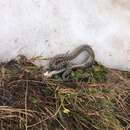ar
الأسماء في صفحات التنقل


Vipera walser, the Walser viper or Piedmont viper is a viper endemic to the western Italian Alps. While long considered as an isolated population of Vipera berus, molecular analyses have shown it to be a distinct species related to the Vipera ursinii-complex.[1][2]
Morphologically, Vipera walser closely resembles the far more widespread Vipera berus. It differs in having a higher number of cephalic scales and more frequently shows fragmentation of the cephalic large shields. Additionally, most individuals possess 1.5 to 2 rows of subocular scales at both sides of the head, while Vipera berus usually only has a single row. Colouration is highly variable, with some specimens possessing a typical dorsal zigzag pattern, and others with a reduced pattern of horizontal bars.[1] Additionally, melanistic individuals exist.
Vipera walser is limited to a small area north of the Italian town of Biella.[1] The range is divided in a northern population of ±45 km² and a southern population of ±225 km².[3]
Vipera walser occurs in open habitats at an altitude of 1300-2300 m in valleys with high precipitation. It is mostly found on gentle south-oriented slopes with low forest cover.[3]
Due to its recent description, Vipera walser has not yet been evaluated by IUCN, although the original species description argues that the limited extent of occurrence (<1000 km²) warrants a classification as 'endangered'.[1] Fragmented habitat, decline in agropastoral landuse, culling and collection pose short-term threats, while in the long term climate change may alter the distribution. Additionally, low genetic variability may make the species even more prone to disturbances.[1]
Vipera walser, the Walser viper or Piedmont viper is a viper endemic to the western Italian Alps. While long considered as an isolated population of Vipera berus, molecular analyses have shown it to be a distinct species related to the Vipera ursinii-complex.